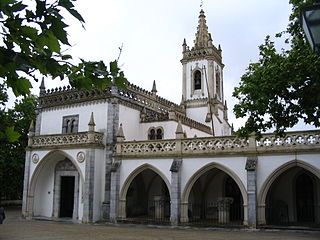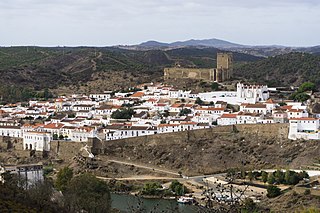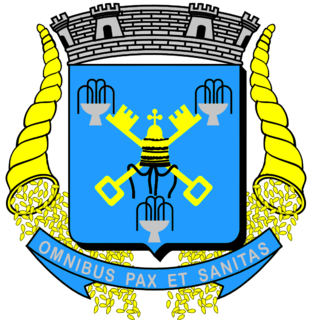
Lusitania was an ancient Iberian Roman province located where modern Portugal and a portion of western Spain lie. It was named after the Lusitani or Lusitanian people.

Caldas da Rainha is a medium-sized Portuguese city in the Oeste region, in the historical province of Estremadura, and in the district of Leiria. The city serves as the seat of the larger municipality of the same name and of the Comunidade Intermunicipal do Oeste. At the 2011 census, the municipality had a population of 51,729 in an area of 255.69 square kilometres (98.72 sq mi), with 30,343 residing in the city. Although the city itself lies about 10.5 kilometres (6.5 mi) inland, three of the municipality's civil parishes lie on the Atlantic Ocean. Caldas da Rainha is best known for its sulphurous hot springs and ceramic pottery.

Administratively, Portugal is de jure unitary and decentralized state. Nonetheless, operationally, it is a highly centralized system with administrative divisions organized into three tiers. The State is organized under the principles of subsidiarity, local government autonomy, and democratic decentralization of the public service.

Beja is a city and a municipality in the Alentejo region, Portugal. The population in 2011 was 35,854, in an area of 1,146.44 km2 (442.64 sq mi). The city proper had a population of 21,658 in 2001.

Serpa is a city and a Concelho (municipality) in the central Portuguese region Alentejo. The population in 2011 was 15,623, in an area of 1,105.63 square kilometres (426.89 sq mi). The Guadiana River flows close to the town of Serpa.

Mértola is a municipality in southeastern Portuguese Alentejo near the Spanish border. In 2011, the population was 7,274, in an area of approximately 1,292.87 square kilometres (499.18 sq mi): it is the sixth-largest municipality in Portugal. Meanwhile, it is the second-lowest population centre by density with approximately 5.62 persons/1 square kilometre (0.39 sq mi).

The Abbey of St. Batholomew, more simply known as the Abbey of Arouca, was a Cistercian monastery of women dating from the 10th century. It is located in Arouca, now in the Porto metropolitan area of Portugal. For much of its existence, it was one of the most influential religious centers in that region of the country.
Dom Heliodoro de Paiva was a Portuguese composer, philosopher, and theologian.

Balsa was a Roman coastal town in the province of Lusitania, Conventus Pacensis.

The Coat of arms of the Municipality of the Hydromineral Spa of Águas de São Pedro is the official coat of arms of Águas de São Pedro.

The Castle of Beja is a medieval castle in the civil parish of Beja, municipality of Beja, Portuguese district of Beja.
The territory that is modern-day Portugal would be romanized in the sequence of the Second Punic War, through the Roman conquest of the Iberian Peninsula.

Myrtilis Iulia was the Roman name given to present day Mértola, Portugal. During Classical Antiquity, Mértola was inhabited by Phoenicians, Carthaginians and finally the Romans, who called it Myrtilis Iulia.

This article covers the history of ancient Portugal, the period between Prehistoric Iberia and County of Portugal.
João de Melo (1405-1486) was a Portuguese nobleman, alcaide-mor of Serpa, and copeiro-mor of Afonso V of Portugal.

The Jew is a 1996 Brazilian-Portuguese co-production film directed by Jom Tob Azulay with Filipe Pinheiro in the title role, Dina Sfat, and Mário Viegas as the king. It tells the story of the writer António José da Silva, nicknamed "the Jew", burned at the stake during the reign of King João V of Portugal in 1739.

Linha do Algarve is a railway line in the region of Algarve, in southern Portugal, which connects the stations of Lagos to the west and Vila Real de Santo António to the east of the Portuguese region.

Dom Frei Manuel do Cenáculo, T.O.R. was a Portuguese Franciscan prelate, who served as the first Bishop of Beja (1770–1802) and as Archbishop of Évora (1802–1814).

Sisenandus of Beja was a Christian deacon and martyr who was put to death during the reign of Abd al-Rahman II, Emir of Córdoba, and is counted among the Martyrs of Córdoba.
José Carreira Marques was a Portuguese politician.





















